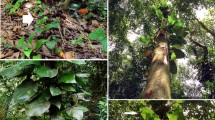Abstract
Lycopodium annotinum, a clonal pteridophyte, was grown under canopies formed by various combinations of deciduousVaccinium myrtillus and evergreenV. vitis-idaea. The canopies differed in red:far-red ratio, withV. myrtillus giving the lowest ratio. The current year's horizontal segments ofL. annotinum had the same specific weight in all treatments, but the lengths of the segments were significantly increased when grown under the canopy ofV. myrtillus compared withV. vitis-idaea. The number of vertical apices was also increased. Both these responses increased the amount of assimilating structures ofL. annotinum when growing under aV. myrtillus canopy. This might be beneficial for the evergreenL. annotinum, since it can then utilize spring and autumn periods when the deciduousV. myrtillus has no leaves.
Similar content being viewed by others
References
Ballaré C.L., Scopel A.L. &Sánchez R.A. (1991): On the opportunity cost of the photosynthate invested in stem elongation reactions mediated by phytochrome.—Oecologia 86: 561–567.
Callaghan T.V. (1980): Age-related patterns of nutrient allocation inLycopodium annotinum from Swedish Lapland.—Oikos 35: 373–386.
Callaghan T.V., Svensson B.M. &Headley A.D. (1986): The modular growth ofLycopodium annotinum. —Fern Gazette 13: 65–76.
Callaghan T.V., Svensson B.M., Bowman H., Lindley D.K. &Carlsson B.Å. (1990): Models of clonal plant growth based on population dynamics and architecture.—Oikos 57: 257–269.
Canham C.D. (1988): Growth and canopy architecture of shade-tolerant trees: response to canopy gaps.— Ecology 69: 786–795.
Casal J.J., Deregibus V.A. &Sánches R.A. (1985): Variations in tiller dynamics and morphology inLolium multiflorum Lam. Vegetative and reproductive plants as affected by differences in red/far-red irradiation.— Ann. Bot. 56: 553–559.
Deregibus V.A., Sánches R.A., Casal J.J. &Trlica M.J. (1985): Tillering responses to enrichment of red light beneath the canopy in a humid natural grassland.—J. Appl. Ecol. 22: 199–206.
Grime J.P. (1981): Plant strategies in shade.—In:Smith H. [ed.]: Plants and the daylight spectrum, Academic Press, London, pp. 159–186.
Headley A.D., Callaghan T.V. &Lee J.A. (1985): The phosphorus economy of the evergreen tundra plantLycopodium annotinum.—Oikos 45: 235–45.
Holmes M.G. (1981): Spectral distribution of radiation within plant canopies.—In:Smith H. [ed.]: Plants and the daylight spectrum. Academic Press, London, pp. 159–186.
Karlsson P.S. (1983): Strategies of light utilization in a deciduous and an evergreen dwarf shrub in subarctic Fennoscandia.—In:Kaurin A., Juntilla O. &Nilsen J. [eds.]: Plant production in the North, Norwegian University Press, Tromsø, Norway, pp. 92–98.
Karlsson P.S. (1987a): Niche differentiation with respect to light utilization among coexisting dwarf shrubs in a subarctic woodland.—Polar Biol. 8: 35–39.
Karlsson P.S. (1987b): Micro site performance of evergreen and deciduous dwarf shrubs in a subarctic heath in relation to nitrogen status.—Holarct. Ecol. 10: 114–119.
Klimeš L. (1992): The clone architecture ofRumex alpinus.—Oikos 63: 402–409.
Mack N.M. &Harper J.L. (1977): Interference in dune annuals: spatial patterns and neighbourhood effects. —J. Ecol. 65: 345–363.
MacLellan A.J. &Frankland B. (1985): A simple field method for measuring light quality: seasonal changes in a temperate deciduous wood.—Photochem. Photobiol. 2: 689–695.
Matlack G.R. &Harper J.L. (1986): Spatial distribution and the performance of individual plants in a natural population ofSilene dioica.—Oecologia 70: 121–127.
Méthy M., Alpert P. &Roy J. (1990): Effects of light quality and quantity on growth of the clonal plantEichornia crassipes.—Oecologia 84: 265–271.
Morgan D.C. (1981): Shade light quality effects on plant growth.—In:Smith H. [ed.]: Plants and the daylight spectrum, Academic Press, London, pp. 159–186.
Morgan D.C. &Smith H. (1981): Non-photosynthetic responses to light quality.—In:Lange O.L., Nobel P.S., Osmond C.B. &Ziegler H. [eds.]: Physiological plant ecology. I. Responses to the physical environment, Springer-Verlag, Berlin, pp. 109–134.
Pitelka J.W. &Ashmun L.F. (1985): Physiology and integration of ramets in clonal plants.—In:Jackson J.B.C., Buss L.W. &Cook R.E. [eds.]: Population biology and evolution of clonal organisms, Yale U.P., New Haven, Connecticut, pp. 399–435.
Robinson D. &Rorison I.H. (1988): Plasticity in grass species in relation to nitrogen supply.—Funct. Ecol. 2: 249–257.
Skálová H. &Krahulec F. (1992): The response of threeFestuca rubra clones to changes in light quality and plant density.—Funct. Ecol. 6: 282–290.
Smith H. (1982): Light quality, photoperception, and plant strategy.—Annu. Rev. Plant Physiol. 33: 481–518.
Solangaarachchi S.M. &Harper J.L. (1987): The effects of canopy filtered light on the growth of white cloverTrifolium repens.—Oecologia 72: 372–376.
Stoutjesdijk P. (1972): A note on the spectral transmission of light by tropical rainforest.—Acta Bot. Neerl. 21: 346–350.
Sutherland W.J. &Stillman R.A. (1988): The foraging tactics of plants.—Oikos 52: 239–244.
Svensson B.M. (1987): Studies of the metapopulation dynamics ofLycopodium annotinum and its microenvironment.—PhD Thesis, Lund University, Lund, Sweden.
Svensson B.M. &Callaghan T.V. (1988a): Small-scale vegetation pattern related to the growth ofLycopodium annotinum and variations in its micro-environment.—Vegetatio 76: 167–177.
Svensson B.M. &Callaghan T.V. (1988b): Apical dominance and the simulation of metapopulation dynamics inLycopodium annotinum.—Oikos 51: 331–342.
Tomasko D.A. (1992): Variation in growth form of shoal grass (Halodule wrigthii) due to changes in the spectral composition of light below a canopy of turtle grass (Thalassia testudinum).—Estuaries 15: 214–217.
Waller D.M. (1986): The dynamics of growth and form.—In:Crawley M.J. [ed.]: Plant Ecology, Blackwell Scientific Publications, Oxford, pp. 291–320.
Wiens J.A. (1976): Population responses to patchy environments.—Annu. Rev. Ecol. Syst. 7: 81–20.
Young J.E. (1975): Effects of the spectral composition of light sources on the growth of a higher plant.—In:Evans G.C., Bainbridge R. &Rackham O. [eds.]: Light as an ecological factor: II, Blackwell, Oxford, pp. 135–160.
Zar J.H. (1984): Biostatistical analysis.—Prentice-Hall, New Jersey.
Author information
Authors and Affiliations
Rights and permissions
About this article
Cite this article
Svensson, B.M., Floderus, B. & Callaghan, T.V. Lycopodium annotinum and light quality: Growth responses under canopies of twoVaccinium species. Folia Geobot 29, 159–166 (1994). https://doi.org/10.1007/BF02803792
Issue Date:
DOI: https://doi.org/10.1007/BF02803792




